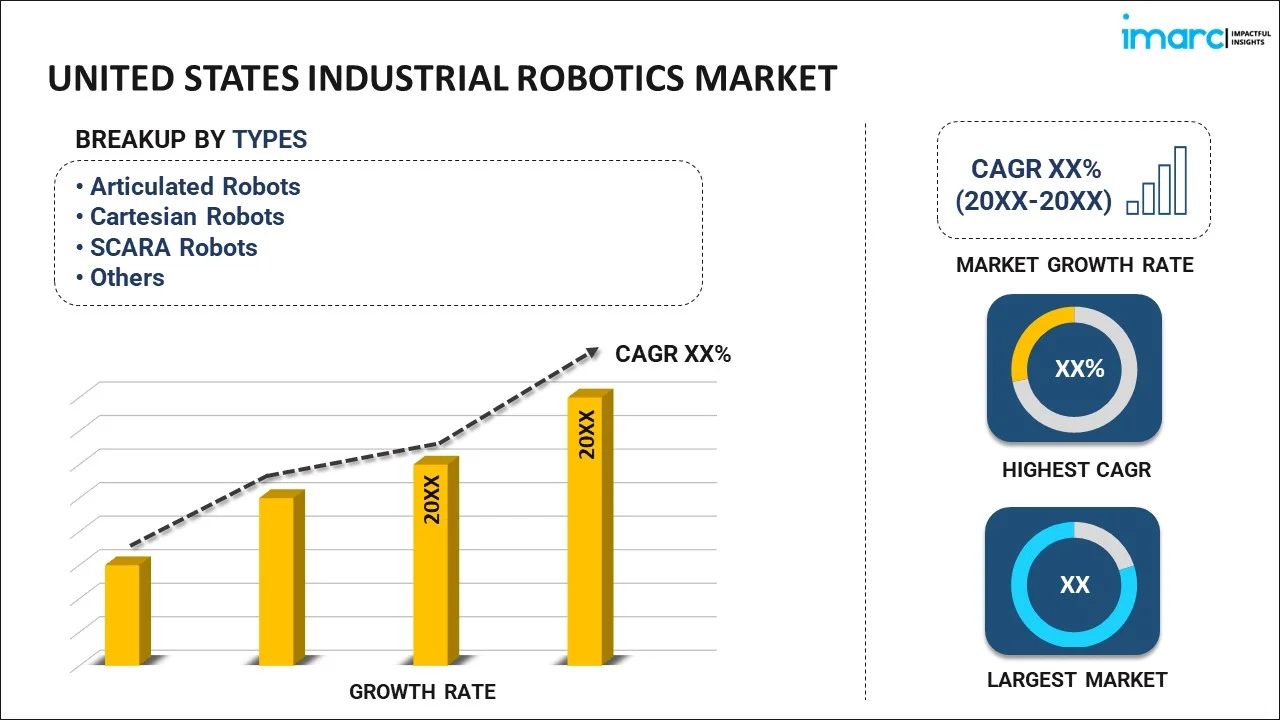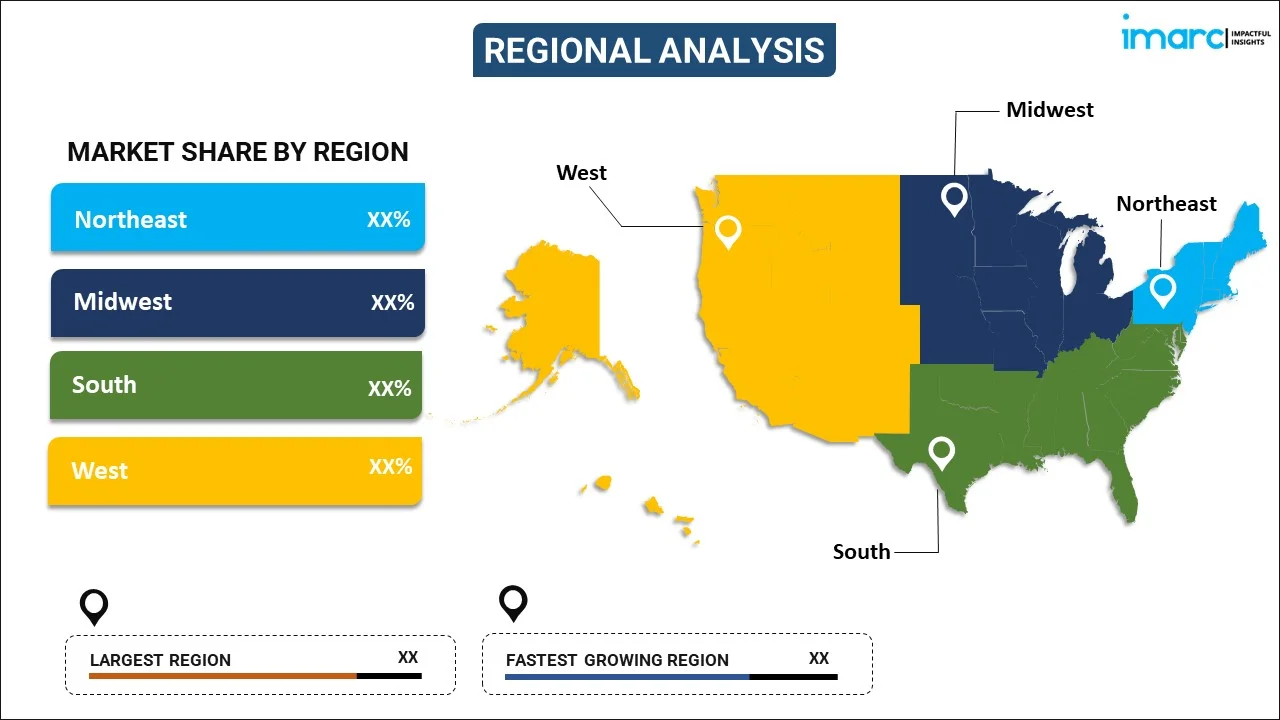
United States Industrial Robotics Market Report by Type (Articulated Robots, Cartesian Robots, SCARA Robots, Cylindrical Robots, Parallel Robots, and Others), Function (Soldering and Welding, Materials Handling, Assembling and Disassembling, Painting and Dispensing, Milling, Cutting and Processing, and Others), End Use Industry (Automotive, Electrical and Electronics, Chemical, Rubber, and Plastics, Machinery and Metals, Food and Beverages, Precision and Optics, Pharmaceutical, and Others), and Region 2026-2034
Market Overview:
United States industrial robotics market size reached USD 2.7 Billion in 2025. Looking forward, IMARC Group expects the market to reach USD 5.5 Billion by 2034, exhibiting a growth rate (CAGR) of 8.11% during 2026-2034. Ongoing technological innovations and the widespread adoption of these devices to streamline processes are primarily driving the market growth.
|
Report Attribute
|
Key Statistics
|
|---|---|
|
Base Year
|
2025
|
|
Forecast Years
|
2026-2034
|
|
Historical Years
|
2020-2025
|
|
Market Size in 2025
|
USD 2.7 Billion |
|
Market Forecast in 2034
|
USD 5.5 Billion |
| Market Growth Rate 2026-2034 | 8.11% |
Access the full market insights report Request Sample
Industrial robotics are automated machines commonly deployed in industrial environments to execute production-related tasks automatically. Their applications encompass a broad range of functions, including painting, welding, packaging, labeling, palletizing, testing, and inspecting industrial products. Furthermore, industrial robotics play a crucial role in mechanical activities such as cutting, grinding, deburring, adhesive sealing, spot welding, and material handling. Their integration contributes to increased production output, enhanced consistency in product quality, waste reduction, improved safety standards, optimal utilization of space and time resources, and the overall enhancement of manufacturing and production processes. As a result, these robotic systems find widespread adoption across various industries, including pharmaceuticals, construction, automotive, chemicals, manufacturing, and the food and beverage (F&B) sector.
United States Industrial Robotics Market Trends:
The United States industrial robotics market represents a cornerstone in the nation's manufacturing and production landscape, where automated machines revolutionize industrial processes. Key functionalities include painting, welding, packaging, labeling, palletizing, testing, inspecting, as well as undertaking mechanical processes like cutting, grinding, deburring, adhesive sealing, spot welding, and material handling. Additionally, their integration yields significant benefits, ranging from increased production capacities and enhanced product quality consistency to waste reduction and improved safety standards, which is acting as another significant growth-inducing factor. Besides this, the United States industrial robotics market plays a pivotal role in optimizing resource utilization, both in terms of space and time, contributing to overall operational efficiency. Furthermore, industries, such as pharmaceuticals, construction, automotive, chemicals, manufacturing, and the food and beverage (F&B), leverage industrial robotics extensively to streamline processes and remain competitive, which is positively influencing the regional market. These robotic systems not only contribute to economic growth but also position the United States as a leader in the industrial automation arena, where efficiency, precision, and reliability is paramount. This, in turn, is expected to fuel the market growth across the country over the forecasted period.
United States Industrial Robotics Market Segmentation:
IMARC Group provides an analysis of the key trends in each segment of the market, along with forecasts at the country level for 2026-2034. Our report has categorized the market based on type, function, and end use industry.
Type Insights:

To get detailed segment analysis of this market Request Sample
- Articulated Robots
- Cartesian Robots
- SCARA Robots
- Cylindrical Robots
- Parallel Robots
- Others
The report has provided a detailed breakup and analysis of the market based on the type. This includes articulated robots, cartesian robots, SCARA robots, cylindrical robots, parallel robots, and others.
Function Insights:
- Soldering and Welding
- Materials Handling
- Assembling and Disassembling
- Painting and Dispensing
- Milling, Cutting and Processing
- Others
A detailed breakup and analysis of the market based on the function have also been provided in the report. This includes soldering and welding, materials handling, assembling and disassembling, painting and dispensing, milling, cutting and processing, and others.
End Use Industry Insights:
- Automotive
- Electrical and Electronics
- Chemical, Rubber, and Plastics
- Machinery and Metals
- Food and Beverages
- Precision and Optics
- Pharmaceutical
- Others
The report has provided a detailed breakup and analysis of the market based on the end use industry. This includes automotive, electrical and electronics, chemical, rubber, and plastics, machinery and metals, food and beverages, precision and optics, pharmaceutical, and others.
Regional Insights:

To get detailed regional analysis of this market Request Sample
- Northeast
- Midwest
- South
- West
The report has also provided a comprehensive analysis of all the major regional markets, which include Northeast, Midwest, South, and West.
Competitive Landscape:
The market research report has also provided a comprehensive analysis of the competitive landscape in the market. Competitive analysis such as market structure, key player positioning, top winning strategies, competitive dashboard, and company evaluation quadrant has been covered in the report. Also, detailed profiles of all major companies have been provided.
United States Industrial Robotics Market Report Coverage:
| Report Features | Details |
|---|---|
| Base Year of the Analysis | 2025 |
| Historical Period | 2020-2025 |
| Forecast Period | 2026-2034 |
| Units | Billion USD |
| Scope of the Report | Exploration of Historical and Forecast Trends, Industry Catalysts and Challenges, Segment-Wise Historical and Predictive Market Assessment:
|
| Types Covered | Articulated Robots, Cartesian Robots, SCARA Robots, Cylindrical Robots, Parallel Robots, Others |
| Functions Covered | Soldering and Welding, Materials Handling, Assembling and Disassembling, Painting and Dispensing, Milling, Cutting and Processing, Others |
| End Use Industries Covered | Automotive, Electrical and Electronics, Chemical, Rubber, and Plastics, Machinery and Metals, Food and Beverages, Precision and Optics, Pharmaceutical, Others |
| Regions Covered | Northeast, Midwest, South, West |
| Customization Scope | 10% Free Customization |
| Post-Sale Analyst Support | 10-12 Weeks |
| Delivery Format | PDF and Excel through Email (We can also provide the editable version of the report in PPT/Word format on special request) |
Key Questions Answered in This Report:
- How has the United States industrial robotics market performed so far and how will it perform in the coming years?
- What has been the impact of COVID-19 on the United States industrial robotics market?
- What is the breakup of the United States industrial robotics market on the basis of type?
- What is the breakup of the United States industrial robotics market on the basis of function?
- What is the breakup of the United States industrial robotics market on the basis of end use industry?
- What are the various stages in the value chain of the United States industrial robotics market?
- What are the key driving factors and challenges in the United States industrial robotics?
- What is the structure of the United States industrial robotics market and who are the key players?
- What is the degree of competition in the United States industrial robotics market?
Key Benefits for Stakeholders:
- IMARC’s industry report offers a comprehensive quantitative analysis of various market segments, historical and current market trends, market forecasts, and dynamics of the United States industrial robotics market from 2020-2034.
- The research report provides the latest information on the market drivers, challenges, and opportunities in the United States industrial robotics market.
- Porter's five forces analysis assist stakeholders in assessing the impact of new entrants, competitive rivalry, supplier power, buyer power, and the threat of substitution. It helps stakeholders to analyze the level of competition within the United States industrial robotics industry and its attractiveness.
- Competitive landscape allows stakeholders to understand their competitive environment and provides an insight into the current positions of key players in the market.
Need more help?
- Speak to our experienced analysts for insights on the current market scenarios.
- Include additional segments and countries to customize the report as per your requirement.
- Gain an unparalleled competitive advantage in your domain by understanding how to utilize the report and positively impacting your operations and revenue.
- For further assistance, please connect with our analysts.
 Request Customization
Request Customization
 Speak to an Analyst
Speak to an Analyst
 Request Brochure
Request Brochure
 Inquire Before Buying
Inquire Before Buying




.webp)




.webp)












